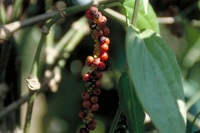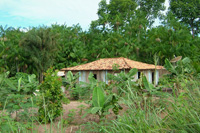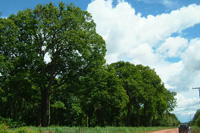Agroforestry in the Amazon
In Tome-Acu, 250 miles south of Belem, situated near the estuary of the Amazon River, Japanese immigrants have been engaged in the tropical agriculture since the 1970s that places a minimal burden on the environment, and they have succeeded in agricultural business, which has attracted worldwide attention.
The Tome-Acu Colony, which used to be called the Acara Colony before the war, was a colony developed by the Nanbei Takushoku Kabushiki Gaisha (South America Colonization Company Ltd) which was founded as a subsidiary of Kanebo Ltd. in Japan before the war, in which Japanese emigrants settled from 1929 onwards. Emigrants, however, failed in cultivating cocoa which was expected to be a main product of the colony, because of their ignorance of tropical agriculture techniques, which caused the management of the colony to come to a deadlock, and in addition, when virulent malaria outbreaks occurred, many settlers were forced to leave the colony.
After the war, the cultivation of pepper diffused and when global pepper prices increased, pepper millionares emerged in the early 1950s. But the infestation of crops with the fungus fusarium dealt a fatal blow to the pepper cultivation in the late 1960s. While many farmers left Tome-Acu one after another in search of the soi free of contaminants to avoid pepper blight, farmers staying there cultivated numerous crops in their home garden through trial and error in search of replacement crops for pepper.
As a result, after slashing and burning the fields, one-year, short-term crops including rice, beans, pumpkin, tomatoes and leafy vegetables will be planted, and then perennial middle-term crops such as pepper and passion fruit will be planted. Middle-term crops will thus grow, while the short term crops will prevent weeds from growing. When the middle-term crops create part shade and effects of windbreak, the seedlings of fruit trees and useful tall tree species (walnut, mahogany and Para rubber tree) will be planted. When the middle-term crops die in five or six years, the fruit trees will bear fruit and the useful trees will have grown to 10m tall. The tall trees will be cut, trimmed and shipped to market before long. Farmers in Tome-Acu thus have developed the agricultural method which creates crop combinations to make it possible to harvest year round without interruption. The number of the crop combinations is innumerable.
Because combinations of crops are cultivated and the cycle of the cultivation is repeated according to the model of the natural vegetation succession from the first stage in which a virgin forest in the Amazon will have burnt down, to the last stage in which the forsest will have been restored in a few decades or centuries, the agricultural method is scholarly called as a transition type of agroforestry.
’Virgin forests are what the community of organisms that has integrated all the plants for hundreds of years is like’ (Noboru Sakaguchi, "Agriculture in the Amazon and international cooperation of Japan"). With the agricultural method, it is said that in farms between half and two thirds of above-ground vegetation biomass (the mass of living biological organisms in a given area) in tropical virgin rain forests in the same region can be restored in 25 years after the seedling of tall tree species.
Today in the Amozon expansion of cattle-ranching drives deforestation and it is the biggest cause of environmental destruction. In Tome-Acu, income from a 25ha farm through agroforestry is equivalent to income from a larger than 1,000ha ranch, and while a cattle ranch requires only 2-3 cowboys, the cultivation of a 25ha farm creates 10-20 pemanent jobs. In addition, the cultivation of various crops in one farm, makes it possible to harvest on it year round without interruption and the cultivation of different combinations of crops for each plot of agricultural land economically assures stable income for farmers. The Brazilian Federal Government and local state governments encourage this settled agricultural method also for non-Japanese small farmers in place of shifting slash-and-burn cultivation.
Japanese immigrants have already contributed to the development of tropical agriculture in the Amazon with their success in cultivating jute and pepper and are also about to make great contributions to the promotion of compatible ways to conserve rainforests in the Amazon and elsewhere, while enhancing agricultural development.











